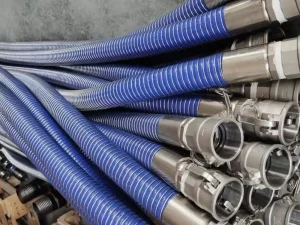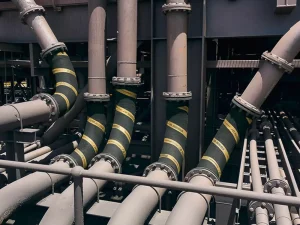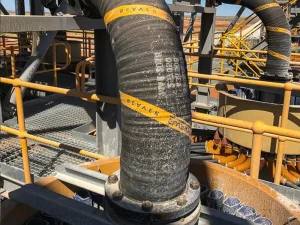In the past, there were very limited types of hoses available. They were mostly weaker and not suitable for transporting abrasive materials. Things have changed mainly due to slurry hoses. These are heavy-duty and designed to carry high-pressure slurry with ease.
What makes them stand out is their robust steel wire reinforcements. You’re in the right place if you know nothing about slurry hoses. In this article, I will explain everything related to slurry hose and its types. You will also learn how to choose a high-quality slurry hose that fits your needs. So, let’s get started!
What is a Slurry Hose?

Before going into details, let’s first get a basic understanding of slurry hoses.
The inner part of these hoses consists of high-quality rubber. The outer surrounding consists of layers of steel ring reinforcement. The layers make the hoses very durable and able to withstand harsh usage. They can easily transport harsh and hard particles mixed with liquid (slurry).
Moreover, manufacturers use them to move gravel, sand, and other materials to the construction industry. Slurry hoses are very popular because of their rugged structure. The outer reinforcement makes them robust. Manufacturers use steel wires for reinforcement and create a layer on the outside.
These layers ensure that these hoses can withstand high-pressure slurry without deteriorating. Remember, regular-use hoses are not very robust. Why? They are only made to bear regular pressure and be used in normal conditions. Moreover, they must be lightweight, so manufacturers make them weaker to optimize weight.
However, the slurry hoses are designed to face extreme pressures. Moreover, it does not only carry water or fluid. Instead, it is used to transfer harsh content (slurry). Remember, slurry is a combination of liquid and hard particles. These particles can have sharp edges that can tear the hose if the hose is weak. Therefore, the slurry hoses consist of reinforcement of steel rings.
Purpose of Slurry Hoses & Key Applications
The primary purpose of a slurry hose is to transport the rough fluid. The slurry, gravel, sand, and other chemicals are the best examples. The regular hose might get torn if you use it to transport these fluids. Why? Because these fluids put extreme pressure on the hose. Moreover, their solid particles can also affect the integrity of the interior.
The hoses are prominently used in mining, dredging, and construction industries. Here are the key applications of slurry hoses in different sectors:
| Industry | Uses of Slurry Hoses |
| Mining | Transporting ores, coal, and minerals mixed with water. |
| Dredging | Helpful in moving sand, mud, and sediments |
| Construction | Helped pump concrete, cement, and sludge |
| Chemicals | Handling abrasive or corrosive chemicals safely. |
| Waste Management | Transferring sludge, wastewater, and industrial residues |
Their usage is widespread, and I have only mentioned a few applications. Their presence is also common in the agricultural sector. It helps transport liquid fertilizers and manure slurry from one location to another. Slurry hoses are usually preferred for transporting harsh chemicals or liquids.
How Do Slurry Hoses Work?

The slurry hoses are connected to a slurry pump through connectors and flanges. This pump creates positive or negative pressure inside the pump. For example, if the hose performs a suction job, the pump will reduce the pressure inside the pump and create a vacuum.
The strong steel rings don’t allow the hose to collapse due to the low pressure inside it. When the pressure inside the hose is very slow, a pressure difference is created between the hose and other sources. As a result, the slurry moves inside the hose from the source. In the second case, the pump creates positive pressure inside the hose.
This means the pressure inside the hose becomes very high. Due to this high pressure, the slurry present in the hose comes out. This happens when pumping the slurry out of the hose is required during the discharge process. The working of the slurry hose can depend on the conditions and use.
Types of Slurry Hoses
There are different types of slurry hoses. Each of them varies in working and performance in various conditions. In the section below, I will discuss some popular types of slurry hoses:
1- Suction Slurry Hose

The suction pipes help slurry out of any source, such as a dredging site or gravel tank. Simply put, the suction hose helps take slurry out of any tank. As I said earlier, these hoses are connected to the pump. This pump creates negative pressure (vacuum) inside the hose.
As a result, pressure inside the hose and source (tank) differ. So, the slurry moves from a high-pressure position (tank) into the hoses at a low-pressure level. These hoses consist of strong rubber material on the inner surface. Moreover, they have reinforced layers of steel wire. This ensures that the hose does not shrink.
2- Discharge Slurry Hose
This type of hose moves the slurry away. Unlike suction hoses, it works when positive pressure is created inside it. The pump increases the pressure inside the hose. Remember, this hose contains the slurry inside it.
When the pressure increases, it pushes the slurry out of the hose. You can use this hose to move the slurry to its destination, i.e., the processing plant. These slurry hoes come with multiple reinforced steel wire layers. These multiple reinforcement layers make the hose bear the high pressure.
3- Floating Slurry Hose
This type of slurry hoses are very unique. The reason is that they are used in marine conditions. Manufacturers add a buoyant materials layer on the exterior of these hoses. So they can easily remain on the water body’s surface and keep floating. Anything such as foam or air filled the exterior layers of these hoses.
They can transport the slurry over water bodies. Generally, the offshore oil and gas industries use them to ensure smooth transportation over water bodies. The exterior steel ring reinforcement doesn’t get rusty because of its coating. Moreover, its flexibility and durability make it fit for marine conditions.
4- Dredging Slurry Hose
Dredging slurry hoses are highly rugged and durable. Their interior consists of multiple layers of high-quality rubber. Similarly, the exterior side consists of multiple reinforced layers for better strength.
They are generally used to transport abrasive slurries during dredging operations. However, people also use them in places where a large amount of gravel or sand needs to be removed. The prominent feature of this type of slurry hose is its durability and ruggedness. They can easily transport sediments and abrasive slurries.
5- Flexible & Armored Slurry Hose
Generally, the slurry hoses are rigid and stiff. So, they require more space for their work. However, these flexible slurry hoses are different as they are very flexible. You can use it in constrained spaces where the regular hoses are ineffective.
Conversely, armored slurry hoses are not very flexible but rugged and durable. They consist of steel rings, wire mesh, and high-quality rubber armor. What I love about this armor hose is its resistance to punctures and cuts. Their strong outer rubber armor shield ensures long-lasting performance from these hoses.
How to Choose the Right Slurry Hoses? Selection Guide
Many factors must be considered during the selection of slurry hoses. A slight mistake can result in the wrong slurry hose that may not fit your needs. Remember, slurry hoses can vary from others, which makes them suitable for different sectors. In the section below, I will guide you through an essential selection guide of slurry hoes:
- Nature of Slurry: First, understand the nature of the slurry being transported. For example, slurries can have a low or high concentration of solids. Low solid slurry can easily flow and does not cause much wear to the hose. However, medium and high solid slurry can cause significant wear. So, choose the hose according to the nature of the slurry.
- Diameter & Length: Choosing the correct diameter and length of the hose is essential. This factor decides the smooth flow of the slurry. For instance, a hose with a large internal diameter allows more slurry to pass and vice versa. But remember, if a hose is too narrow, slurry flows at high speed and can cause wear.
- Temperature Consideration: Temperature highly affects hose performance. Both the slurry and the surrounding temperature must be considered. For example, choose a cold-resistant rubber hose if the slurry is too cold. For hot slurry, you should prefer heat-resistant hoses such as silicone hoses. Moreover, select hoses that remain unaffected by low or high surrounding temperatures.
- Material of Hose: Slurry hoses are made of various materials that differ in quality. You should choose the hose with higher durability. For example, reinforced hoses last longer and can handle high slurry pressure. Moreover, you should choose a material that ensures abrasion and temperature resistance.
- Maintenance Cost: Lastly, balancing cost and performance is essential. Choosing a cheap hose can lead to frequent replacement. This increases the overall cost and maintenance. However, a hose with a higher initial cost and good performance is a wise choice. It will not need replacements and repairs that can prove cost-effective in the long run.
Conclusion
Due to their durability, slurry hoses are becoming more popular in large industries. They can easily transport harsh and abrasive slurries and chemicals. People often confuse a slurry hose with a mining hose. Remember, they are different.
In this article, I have discussed everything related to slurry hoses. You’ll learn how they work, the basic types, and a detailed selection guide. Remember, hose quality varies depending on many factors, such as the number of reinforced layers. You should choose the hose that perfectly meets your needs and uses.
